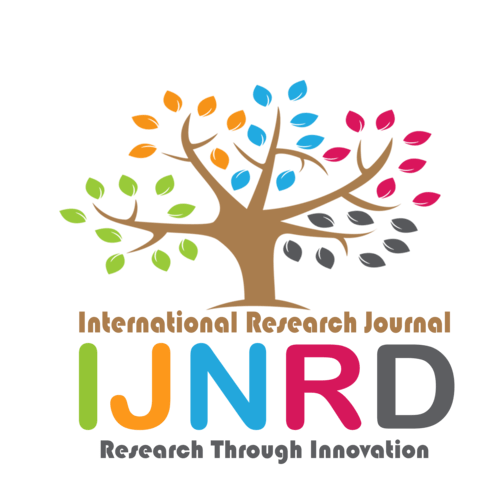|
|||||||||||||||

|
INTERNATIONAL JOURNAL OF NOVEL RESEARCH AND DEVELOPMENT International Peer Reviewed & Refereed Journals, Open Access Journal ISSN Approved Journal No: 2456-4184 | Impact factor: 8.76 | ESTD Year: 2016 Scholarly open access journals, Peer-reviewed, and Refereed Journals, Impact factor 8.76 (Calculate by google scholar and Semantic Scholar | AI-Powered Research Tool) , Multidisciplinary, Monthly, Indexing in all major database & Metadata, Citation Generator, Digital Object Identifier(DOI) |
||||||||||||||
Issue: April 2024
Volume 9 | Issue 4
Review Result and Publication of Paper within : 2-3 days
Click Here For more DetailsFor Authors
Forms / Download
Published Issue Details
Editorial Board
Other IMP Links
Facts & Figure
Impact Factor : 8.76
Issue per Year : 12
Volume Published : 9
Issue Published : 95
Article Submitted :
Article Published :
Total Authors :
Total Reviewer :
Total Countries :
Indexing Partner
Join RMS/Earn 300
Licence
This work is licensed under a Creative Commons Attribution-NonCommercial 4.0 International License







|
Published Paper Details
|
|
| Paper Title: | CANNABIS SATIVA AND ITS ROLE IN NEUROTRANSMITTERS - A CRITICAL REVIEW |
| Authors Name: | Dr. Ankita Singh , Dr. Ramesh Chandra Tiwari , Dr. Manisha Dikshit , Dr. Ved Bhushan Sharma , Dr. Bhawana Mittal |
| Download E-Certificate: | Download |
| Author Reg. ID: |
IJNRD_200771
|
| Published Paper Id: | IJNRD2306644 |
| Published In: | Volume 8 Issue 6, June-2023 |
| DOI: | |
| Abstract: | Bhanga is one of the plant described in ayurvedic literature. Bhanga (Indian hemp, pot, dope) is a Neurotoxic cerebral deliriant poison, obtained from Cannabis sativa. It is the oldest plant to be cultivated in the past 10,000 years for both agricultural and industrial use. It is used for both social and legal purposes for recreational and therapeutic purposes. Its cultivation is restricted by law due to its excessive use for Addiction as it owes psychoactive compounds. The Cannabis sativa plant contains more than 400 chemical compounds, including over 100 Phytocannabinoids, which can cause drug-like effects in humans. The most well-known are delta-9-tetrahydrocannabinol (THC), which produces a mental “high,” and cannabidiol (CBD) cannabis can be smoked, inhaled, taken by mouth, rubbed into the skin, or mixed into food and beverages. With a recent increase in the rates of cannabis use disorder (CUD) and a decrease in the perceived risk of cannabis use, it is crucial to assess the addictive potential of cannabis. It is enclosed Under Narcotic drugs and psychotropic substances (NDPS) Act 1985. The common preparation of the plant are Majoon, Ganja, Hashish/charas. The derivative of bhanga is resin and the active principle constituents of resin are cannabinol, cannabidiol. The main chemical, which is responsible for its pleasurable effects, is called delta-9-tetrahydrocannabinol or THC. In Agad Tantra, bhanga is described as CNS stimulant. In ayurveda it is described as pramastisk-prabhavak (CNS stimulant), Pralapaka (blabbering), and vibhramjanak (delusion) visha. It has been used for various therapeutic purposes as it acts as a sedative and have numerous pharmacological effects on both human and animal trial. Its management and effects have been mentioned very well in ayurvedic literature and modern science. In this article, we will review about the ayurvedic literature of bhanga, its mechanism and effects on the brain. |
| Keywords: | Bhanga; Ayurveda; Cannabis sativa; Ethanocannaboid system. |
| Cite Article: | "CANNABIS SATIVA AND ITS ROLE IN NEUROTRANSMITTERS - A CRITICAL REVIEW", International Journal of Novel Research and Development (www.ijnrd.org), ISSN:2456-4184, Vol.8, Issue 6, page no.g423-g428, June-2023, Available :http://www.ijnrd.org/papers/IJNRD2306644.pdf |
| Downloads: | 000118759 |
| ISSN: |
2456-4184 | IMPACT FACTOR: 8.76 Calculated By Google Scholar| ESTD YEAR: 2016 An International Scholarly Open Access Journal, Peer-Reviewed, Refereed Journal Impact Factor 8.76 Calculate by Google Scholar and Semantic Scholar | AI-Powered Research Tool, Multidisciplinary, Monthly, Multilanguage Journal Indexing in All Major Database & Metadata, Citation Generator |
| Publication Details: |
Published Paper ID:IJNRD2306644 Registration ID: 200771 Published In: Volume 8 Issue 6, June-2023 DOI (Digital Object Identifier): Page No: g423-g428 Country: haridwar, Haridwar, India Research Area: Medical Science Publisher : IJ Publication Published Paper URL : https://www.ijnrd.org/viewpaperforall?paper=IJNRD2306644 Published Paper PDF: https://www.ijnrd.org/papers/IJNRD2306644 |
| Share Article: | |
|
Click Here to Download This Article |
|
| Article Preview | |
|
|
|
Major Indexing from www.ijnrd.org
| Semantic Scholar | Microsaoft Academic | ORCID | Zenodo |
| Google Scholar | ResearcherID Thomson Reuters | Mendeley : reference manager | Academia.edu |
| arXiv.org : cornell university library | Research Gate | CiteSeerX | PUBLON |
| DRJI | SSRN | Scribd | DocStoc |
ISSN Details
 |
 |
ISSN: 2456-4184
Impact Factor: 8.76 and ISSN APPROVED
Journal Starting Year (ESTD) : 2016
DOI (A digital object identifier)
Conference
Open Access License Policy
Important Details
Social Media
| Copyright © 2024 - All Rights Reserved - IJNRD |












Facebook Twitter Instagram LinkedIn